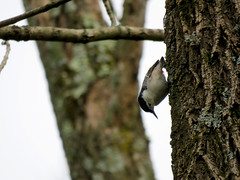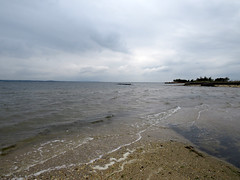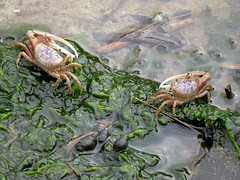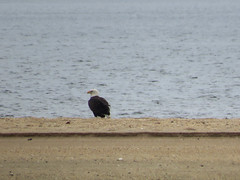
Female goldfinch on thistle

Male goldfinch eating thistle seed

Thistle flowers before turning to seed

Thistledown everywhere!
Think back to the days of your youth (or maybe it was just the other day). Did you ever pick dandelions after they became seeded, blowing on them to make the fluffy seeds fly into the air? Or, did you wave them rapidly back and forth for the same effect? We called the seeds “wishies.” Sometimes we’d randomly see “wishies” floating by and try to catch them, storing up as many wishes as possible. I don’t think we ever thought about the fact that we were helping to disperse dandelion seeds into the manicured lawns of the neighborhood. Some of those “wishies” we caught might not have been from dandelions; they could have been from thistles.
Thistle seeds are similar in appearance to dandelion seeds. Before seeding, the thistle has a beautiful purple flower, as well as spiny leaves to give the plant some protection. When the thistle flower turns to seed, the seedheads are larger than dandelions but with the same whitish, feathery appearance. The thistledown, attached to the seeds, gives them their airy abilities. The thistle also gets a little help in the dispersal process from goldfinches who love its seed. We have a birdfeeder in the backyard just for thistle seed; the goldfinches visit this feeder almost exclusively.
While at the park the other day, I saw goldfinches going crazy over the thistle that was growing in a field of wildflowers. From plant to plant, the birds were picking at the thistle seeds. As they feasted, they were causing the thistledown to fly all over the place. Some of the goldfinches were covered in thistledown. It made me think about how people love to eat Jersey-fresh tomatoes picked right off the vine in the summer. In the winter, those tomatoes on-the-vine from a grocery store are acceptable, but they don’t compare to the taste of a handpicked, in season, straight from the garden treat. Maybe the goldfinches feel that way about eating beak-picked seed directly from the thistle, instead of packaged seed from a birdfeeder. They were certainly behaving like they enjoyed it right from the source. After floating away, the downy part isn’t wasted; some of it may be used for nesting materials.
In the past, when I saw dandelion or thistle seeds floating by, I never thought about how they got into the air. They might have taken flight all on their own, or perhaps, they had the help of a goldfinch.






































